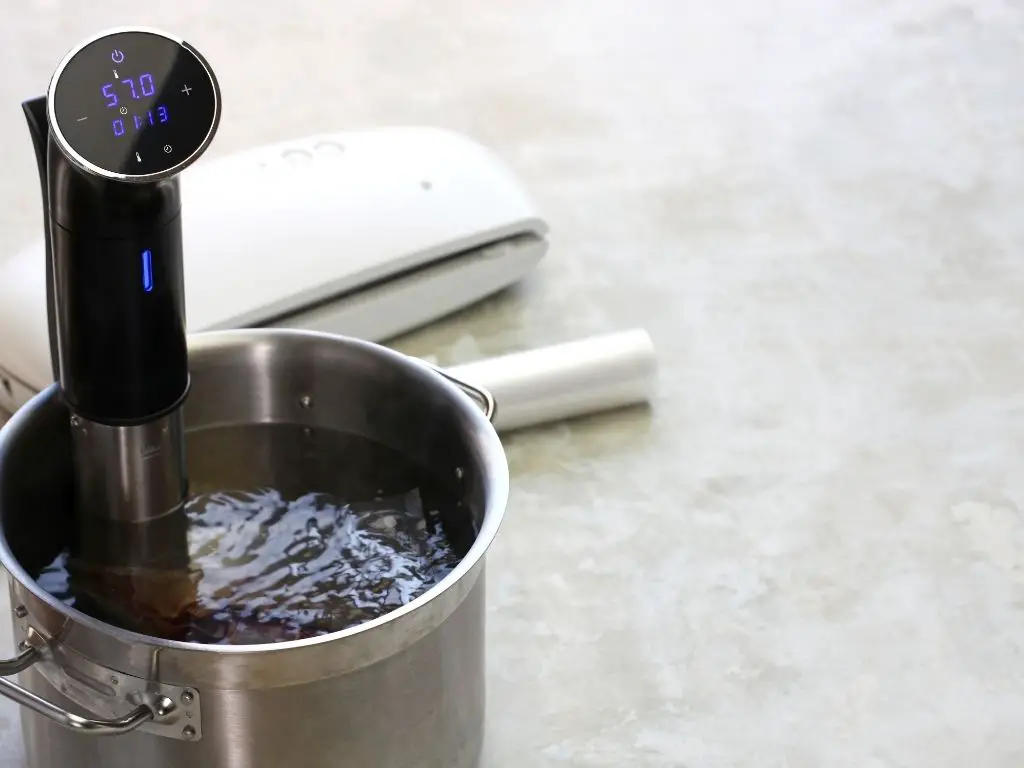Sous vide requires two main pieces of equipment – an immersion circulator and a vessel to hold water. Here are the general price ranges:

Sous Vide Products I Use Every Day
As an Amazon affiliate, I earn from qualifying purchases.
Last update on 2025-03-03 / Affiliate links / Images from Amazon Product Advertising API
Entry-Level Sous Vide Equipment Costs
At the lower end, you can get started with sous vide for $100-200. Immersion circulators in this range from companies like Anova and Chefman allow you to precisely control water temperature. Pair this with any large pot or container you already have at home.
Mid-Range Sous Vide Equipment Costs
For $200-500, you can get more advanced immersion circulators with wifi/Bluetooth connectivity and improved accuracy from brands like Breville and Sansaire. You may also want to invest in a lightweight, stackable sous vide container.
High-End Sous Vide Equipment Costs
High-end circulators like the PolyScience CREST ($500+) offer cutting-edge precision and convenience features. Pair this with a specialized sous vide water oven or chamber vacuum sealer for maximum functionality. Expect to spend $800+ for an extensive setup.
What Are the Benefits of Sous Vide Cooking?
Here are some of the biggest advantages that sous vide offers for home cooks:
1. Precise Temperature Control
Sous vide allows you to set and maintain a very specific temperature throughout cooking. This level of precision helps ensure food is cooked perfectly edge-to-edge without over or undercooking.
2. Consistent Results
Take the guesswork out of cooking with sous vide. Achieve the exact doneness you prefer every time for foods like steak, chicken, fish, eggs, vegetables, and more.
3. Enhanced Flavor and Texture
The low, slow sous vide cooking method tenderizes meats and concentrates flavors in a unique way. Foods come out incredibly moist and tender with a “melt-in-your-mouth” texture.
4. Less Food Waste
With no risk of overcooking, it’s easy to cook extra food sous vide. Leftovers keep well and reheat beautifully. Sous vide makes cooking in bulk simple.
5. Easy Meal Preparation
Simplify weeknight cooking by using sous vide to cook proteins, veggies, sides, and more in advance. Assembly is a breeze once components are pre-cooked to perfection.
6. Nutrient Retention
The sealed sous vide pouches lock in moisture, vitamins and minerals. Sous vide cooking retains nutrients better than higher-heat traditional cooking.
Is Sous Vide Cooking Worth the Investment?
For cooks looking to elevate their home cooking, sous vide is absolutely worth the investment. The ability to achieve precise control and cooking perfection is unparalleled. However, there are some downsides to consider:
Cost – With high-end setups running $500-1000, the equipment is a significant investment. Units in the $200 range are more affordable.
Learning Curve – There is a small learning curve to sous vide in terms of dialing in the right times and temperatures for different foods.
Time – To pasteurize and tenderize food, sous vide recipes can take much longer than standard cooking. But minimal active effort is required on your part.
Limitations – Sous vide excels at proteins, vegetables, eggs, and some starches. But it can’t replicate crispy textures or caramelization.
Counter Space – You’ll need space to accommodate an immersion circulator, as well as storage for bags and containers.
Overall, most home cooks agree that sous vide’s benefits are well worth any drawbacks. Mastering this precise cooking technique offers foolproof meal prep and elevated results. The initial investment pays for itself over time in food cost savings from less waste. Even budget-friendly immersion circulators can improve your cooking.
What Are Some Popular Sous Vide Recipes and Techniques?
Here are just a few of the many foods perfectly suited to sous vide cooking:
Steak – Tenderloins, strip, ribeye, etc come out tender edge-to-edge with no gradient. Cook to your desired doneness between 120-135F. Finish with a quick sear.
Chicken Breasts – Brined chicken breasts are succulent and undry after cooking sous vide. Cook between 140-150F.
Fish – Salmon, cod, tuna, and other fish stay delicate and moist using sous vide. Cook between 115-125F.
Vegetables – Green beans, carrots, beets, potatoes, and more shine when cooked sous vide, maintaining bright colors and textures. Use temperatures between 180-200F.
Eggs – Achieve the perfect poached or soft boiled egg sous vide. Cook low and slow between 140-150F.
Cheesecake – Sous vide cheesecake comes out smooth and silky without cracks. Cook at 165F.
With sous vide, food is seasoned and sealed in a vacuum bag before going into the precise temperature water bath. Herbs, marinades, and butter can infuse flavors during cooking. Afterward, quickly sear or brown foods in a skillet to finish.
Conclusion
From tender steaks to velvety custards, sous vide makes cooking like a professional chef approachable for home kitchens. Although sous vide requires an initial equipment investment, it can elevate your cooking and significantly cut down on food waste over time. For cooks looking to expand their skills with a revolutionary technique, sous vide is well worth considering.


![IMPRESA [10 Pack] Sous Vide Magnet Weights for Keeping Bags Submerged – Sous Vide Accessories to Stop Floating Bags & Undercooking – Weighted Magnets for Containers](https://m.media-amazon.com/images/I/41zHpl8G2lL._SL160_.jpg)

